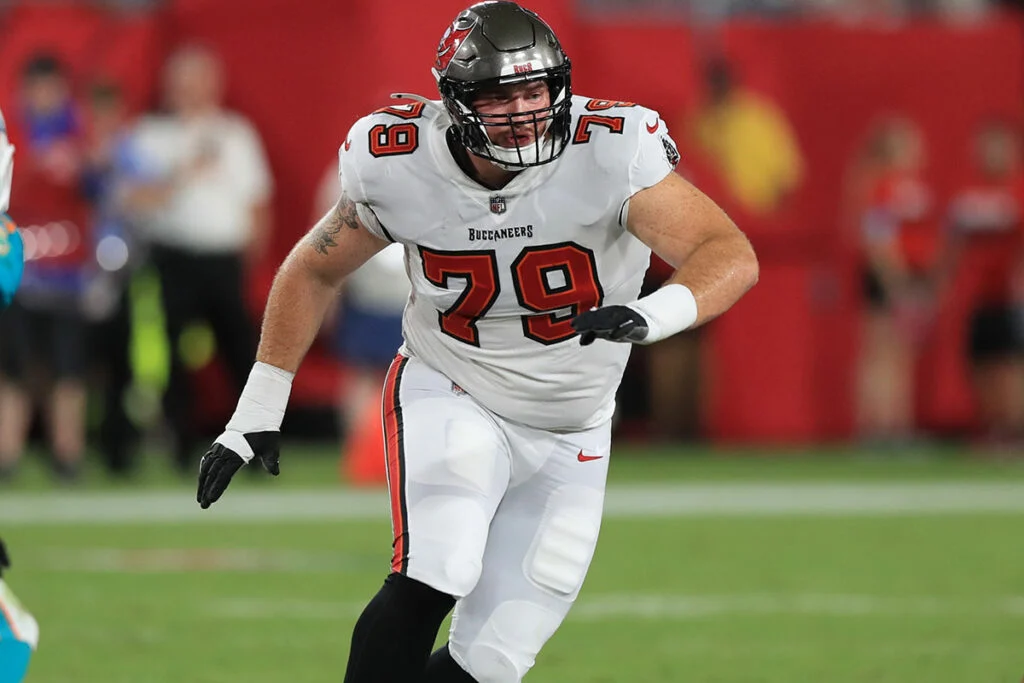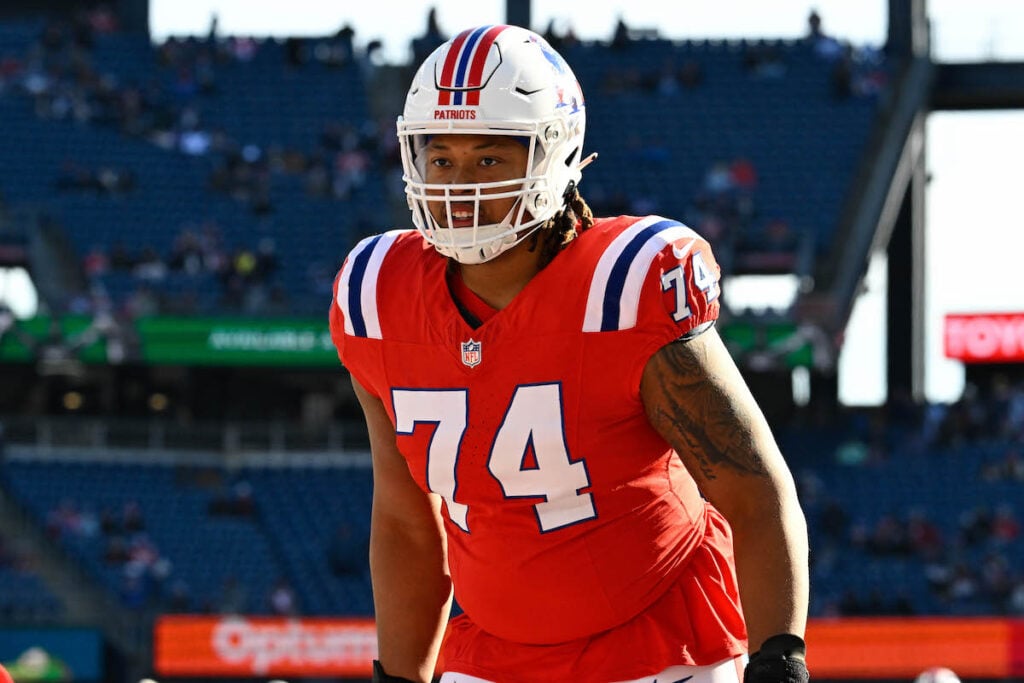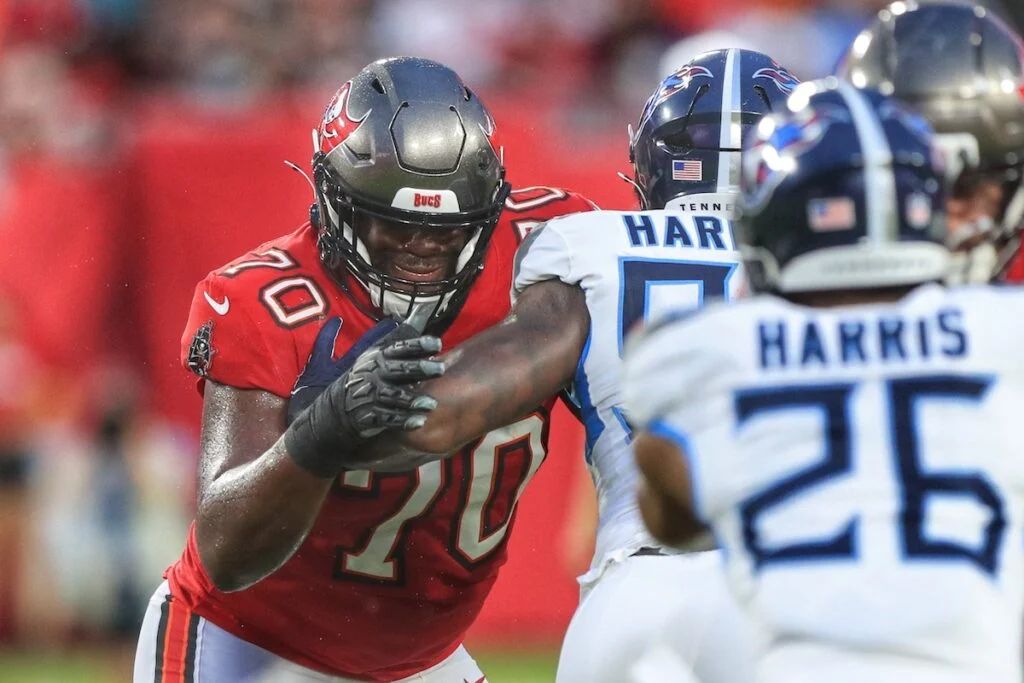While the Bucs kept all of their offensive starters last year, they had some key losses at the second level of their depth chart. These occurred mostly across their offensive line. Backup center Robert Hainsey, who was a solid starter for the team in 2022 and 2023 departed for a starting role in Jacksonville with former offensive coordinator Liam Coen.
Swing tackle Justin Skule opted for a higher likelihood of playing time in Minnesota after providing key starts for the Bucs last year when left tackle Tristan Wirfs and right tackle Luke Goedeke each had to miss time due to injury. Minnesota’s own stellar left tackle Christian Darrisaw was not expected to be ready for the start of the season after a knee injury ended his 2024 season prematurely. Skule was hoping to be able to put together a few extra starts of tape and decided to go with a better chance of that happening with the Vikings.
Royce Newman, a reserve guard you may have forgotten was on the team last year because he played just three snaps, was a veteran with past starting experience in case Cody Mauch or Ben Bredeson missed any time. He departed in free agency for Arizona, although there are no indications the Bucs tried to hold onto him.
Each of those players filled a role that needed to be replaced. And based off of the look of the replacements, the Bucs have types.
Veteran Swing Tackle
Charlie Heck is set to start the season as the team’s left tackle until Tristan Wirfs is recovered from knee surgery. Like Justin Skule, Heck is a former Day 3 pick with 23 career starts. When Skule joined the Bucs in 2022 his play was not near the level it was by the time he left. His pressure rate allowed during his time in San Francisco was 9.1% but showed some promise as a run blocker in Kyle Shanahan’s system. In his most extensive play with the Bucs last year, he cut that pressure rate allowed to 5.9% and helped Tampa Bay’s run game to a top 5 showing.
Bucs LT Charlie Heck – Photo by: Cliff Welch/PR
Heck’s limited play in the preseason thus far has been solid, if unspectacular. Outside of a tough opening drive against the Steelers last week where he had a false start and gave up a quick pressure to Nick Herbig, Heck has looked the part of capable spot fill-in that Skule vacated. The Bucs will give him plenty of help until Wirfs can return but he should provide a similar level of play to Skule.
Heck comes to Tampa Bay with a larger body of work and a lower pressure rate allowed than Skule had before his arrival. He’s leaner than Skule and lacks the same core strength, and if he can maintain his pad level he will give the Bucs what they need.
Homegrown Backup Center
Robert Hainsey was an internal piece the team developed in house. After drafting him in the third round of the 2021 draft they converted him from right tackle to center. He played 31 snaps his rookie year before he was pressed into the starting role when Ryan Jensen suffered what ended up becoming a career ending injury.
Hainsey lacked the strength and build of an interior player and had to learn the center position, but the Bucs successfully turned him into a capable starter. He looked fantastic in his final start with Tampa Bay last year against the Saints. So good in fact, he was one of the key pieces Liam Coen sought in establishing his offense with the Jaguars. Hainsey excelled as a quick, out in space player, but lacked a strong anchor which gave him trouble against stronger nose tackles.
At the outset of this off-season it looked like the Bucs were going to turn to turn one of two undrafted free agents into their new Hainsey. Jake Majors out of Texas seemed like the leader in the clubhouse. Majors was billed as a small, but smart center who could communicate protection assignments and move in space well. But he lacked size and strength which is a big reason he went undrafted. Does that sound like anyone you know?

Bucs G Elijah Klein – Photo by: Cliff Welch/PR
But as training camp has worn on and the preseason started, the Bucs have turned to 2024 sixth-round draft pick Elijah Klein, a career guard to step into the second-team center spot. Klein is still learning the snap-to-movement timing that is crucial for the position, but his performance at the pivot has been promising. He brings a different skillset to the position. He’s stronger than Hainsey and Majors, with a better anchor, but he’s less athletic in space. There haven’t been any obvious line communication errors while he’s been in charge of the unit, which is the most promising sign of his growth and ability to step in if called upon.
Due to uncertainty and lack of primetime playing experience, this is a downgrade from Hainsey – but with upside to be as good of a depth piece. Klein may limit some of the things the Bucs can ask of the position on the perimeter as a puller on tosses as well as the screen game, but his ability to pin, wall and double could improve the team’s gap-based run game.
Former Starting Guard
When the Bucs brought in Ben Bredeson and Sua Opeta last year the plan was for one of them to win the starting left guard spot and the other to fill the role of veteran swing backup. Bredeson had just under 2,000 career snaps across all three interior spots, while Opeta had just under 1,000. Opeta tore his ACL in training camp and was out for the season, defaulting Bredeson to the starting spot. When the Packers waived Royce Newman during final cut downs the Bucs saw it as a chance to place key experience on their depth chart.
That experience is obviously something Tampa Bay covets as they re-signed Opeta this off-season. It is apparent he is still not ready to return from his knee injury as he has yet to play in preseason action, the team has found another experienced veteran. The team has signed Mike (formerly Michael) Jordan to provide insurance for Opeta’s recovery.

Bucs OT Michael Jordan – Photo by: USA Today
The Bucs mark Jordan’s fourth team in seven years. The former fourth-round pick has 40 career starts. But almost every one of those has been average at best, and more often than not they have been subpar. Last year with the Patriots he ranked tied for 43rd out of 58 qualifying guards in pass block efficiency according to Pro Football Focus, and his 5.22% pressure rate allowed was 37th.
With Wirfs sidelined, it appears the Bucs are hoping Jordan can slide into Heck’s spot as the backup swing tackle. That experiment has not gone well in the preseason. Against the Steelers, he allowed Jack Sawyer to beat him both inside and around the edge on multiple reps. Jordan lacks the foot speed to set deep enough to protect his outside shoulder while also being able to shift back inside against counters while also struggling to pass off games with Luke Haggard.
If the Bucs don’t roster Jordan, as Scott Reynolds has predicted with his latest SR’s Fab Five, detailing his 53-man roster predictions, it would be a departure from the team’s typical motus operandi. But there is a solid chance Haggard is a better swing tackle, and perhaps a better guard as well. Jordan is not a lock to make the team just because of his experience.

Bucs OT Ben Chukwuma – Photo by: Cliff Welch/PR
And rookie undrafted free agent Ben Chukwuma has looked better than promising in preseason action. But with Elijah Klein’s development perhaps the team is willing to truly have a backup swing interior lineman, where they exclusively wanted Robert Hainsey at center in recent years. If so, the combination of him, Haggard and Chukwuma could make their desire for Jordan’s archetype a moot point. If so, I’d bet Klein’s presence as a slight upgrade over what Royce Newman provided last year.
None of these changes are a surefire upgrade. The Bucs need to hope for health on the outside of the line. A loss of Heck or Goedeke while Wirfs is still out could prove to be catastrophic on a short-term basis. But if the team were to lose an interior player for a game or two, they should be able to survive.
Long-term the depth on the Bucs has some intriguing pieces. Klein could be pushing for a starting role next year and Chukwuma could provide a long-term, cost-controlled backup tackle to replace Heck in 2026, and that would solidify some core backup needs for years to come.